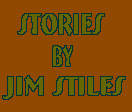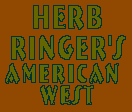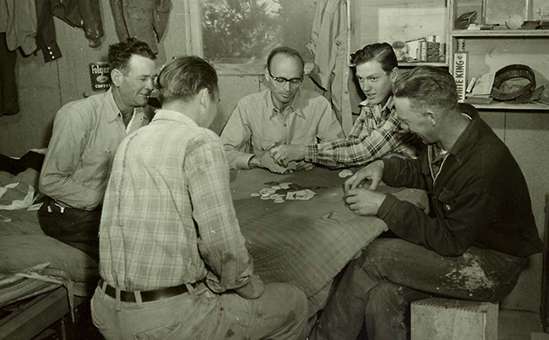

In order to follow the history of the exploration and development of the Big Indian mining district it is necessary to understand a few things about the geology of the uranium ore deposits that were found after Charlie Steen discovered the Mi Vida mine. The most important thing to remember is that none of the ore deposits discovered during the next four years were exposed on the surface. Although the ore bearing host rocks in the Moss Back member of the Chinle formation did outcrop in a few places along the face of the escarpment overlooking the Big Indian Wash, all of the uranium that was found after 1952 was discovered by exploration drilling. My father’s discovery proved that someone could walk over $100 million worth of uranium ore without knowing what lay beneath their feet unless they were willing to risk money on wildcat drilling in the search for totally hidden ore deposits.
Although the Big Indian mining district was developed from the single drill hole Charlie Steen had drilled through 14 feet of high-grade uranium ore on July 6, 1952, none of the other mines in the district were brought into production on the basis of one drill hole. After the Mi Vida mine proved the existence of uranium ore in the Chinle formation, drilling became the chief guide to finding more ore in the district. Any drill hole that encountered good mineralization of minable thickness required additional drilling to block out the ore body. Remarkably, every hole in good ore was later developed into an ore body. Because there were no low-grade halos surrounding the ore bodies, a drill hole could miss penetrating a high-grade deposit by a few feet without finding any trace of uranium. Perhaps the best example of this is the original discovery drill hole on the Mi Vida claim. If my father hadn’t insisted on pushing the bulldozer road as far down dip as possible before he set up his drilling rig, he probably would have missed the Mi Vida ore deposit. Once the mine was blocked out, it was found that the discovery drill hole was located near the outer edge of the ore body. If Charlie Steen had drilled another 18 feet back towards the rim, he would not have cored through the 14 feet of high-grade uranium ore that started the Big Boom at the Big Indian.
After the hole came in on the Mi Vida claim, more than 2.2 million feet of drilling was completed in over 3,000 drill holes spaced between 200 and 500 feet apart during the next twelve years of exploration activity. Drilling reached an all time high in 1956, when more than 647,000 feet were drilled. This exploration drilling delineated a mineralized belt on the southwestern flank of the Lisbon Valley anticline that was approximately eleven miles long and between one-half and one mile wide. A five-mile long portion of the south central part of the anticline had been removed by erosion, leaving about six miles of the mineralized belt to the northwest and about five miles to the southeast. This belt of uranium mineralization follows the same trend my father reasoned existed when he was first drawn to the area. It confirmed his geologic theory that the uranium deposits in this district were structurally controlled by the anticline. As the Lisbon Valley anticline is plunging at the north end, the ore-bearing host rocks in the Moss Back member of the Chinle formation are found at greater depths to the northwest of the crest of the anticline where the Mi Vida and Big Buck claim groups were located.
All the larger ore deposits were tabular and mostly rectangular in shape with an irregular outline. The smaller ore deposits were more rounded in shape, but also tended to be elongated along the flank of the anticline. At the north end of the ore belt, the mines were developed in a cluster of nearly coalesced, large ore deposits that produced more than 30 million pounds of uranium oxide. A dozen smaller deposits that contained over 4 million pounds of uranium oxide were scattered between the northern portion and the central portion of the mineralized belt where the large Mi Vida and Big Buck ore deposits were developed. The cluster of Moss Back hosted ore deposits in this central portion of the belt produced over 22 million pounds of uranium oxide. Another 1.5 million pounds of uranium oxide was taken from a number of widely scattered, smaller deposits in the Moss Back member of the Chinle formation at the south end of the belt.
The uranium deposits ranged in size from 500 to 1,500,000 tons of ore, and in thickness from a few feet to 45 feet with an average of about 6 feet. When my father had first examined the Lisbon Valley anticline, he figured that any uranium concentrated down dip from the low-grade rim outcrops would be found in thicker deposits on this part of the structure. And the thickest ore horizon was found in the Mi Vida and Big Buck mines, where the thickness varied from 10 to 45 feet. Ore grades averaged 0.37 percent uranium oxide, making the Big Indian mining district the highest grade of all of the large uranium districts discovered during the next ten years of exploration on the Colorado Plateau.
By the time that the Mi Vida mine began production, Dad had already insulated his original claim block with more claims, but he was concerned that the Atomic Energy Commission (the AEC) would withdraw the area from public entry. Under the Atomic Energy Act of 1946, all fissionable materials were reserved to the United States government. There was even some question if new mining claims could be located to claim uranium minerals.
Charlie Steen knew that if other prospectors located enough claims in the district that the AEC would not be able to withdraw his claims from private exploitation. If this seems far-fetched, just recall that this was during the Cold War. The uranium ore found in the Mi Vida mine was considered to be of great strategic importance in the atomic arms race with the Soviet Union. For several years, the ore produced at the Mi Vida mine was the largest single source of uranium in the United States. All of that uranium went into atomic weapons, which were vital to the defense of the country. My father encouraged every friend and fellow prospector he knew to get in on the ground floor before the AEC withdrew the area from mineral entry.
Dad always told me that if he had discovered the Mi Vida mine while he was working as a geologist for a mining company, it would have been the high point of his professional career. Because he was prospecting on his own account, the discovery completely changed Charles A. Steen’s life. If he had been working for a mining company, none of what subsequently happened at the Big Indian would have occurred. A mining company would have kept the news of a discovery secret while it blanket staked the entire district. As it happened, more than 2 miles of the north end and about 5 miles of the south end of the mineralized belt remained open until the first months of 1953.
In the frenzied rush to the Big Indian that followed the realization that something extraordinary was happening south of La Sal, Utah, a handful of venturesome individuals seized the opportunity to strike it rich. As a result of the ensuing stampede of claim stakers, most of the ore deposits on the north end of the Lisbon Valley anticline ended up being staked by more than one locator. And, after the prospectors sold their claims, grabbed their millions and left the district to the mining companies that were better able to exploit these deeper ore bodies, most of these uranium deposits were mined by several companies.
About four months after the Mi Vida mine began to bury the AEC’s ore buying station at Thompson in uranium ore, my father realized that he had to do something to quicken the pace of exploration on his claims. The only drilling rig available was a core rig that seemed to take an eternity to reach the ore horizon when it had to drill through the full thickness of the Wingate and Chinle formation. When his then partners, Bob Barrett and Dan O’Laurie, resisted his plans to buy a modern Mayhew rotary drilling rig, Charlie Steen hit on the idea of raising money by selling an interest in some of the claims he hadn’t contributed to Utex.
After forming a company he named Big Indian Mines, Dad conveyed six of his claims to this new entity and headed down to Texas to raise enough money to explore these properties. When he came back he brought along his brother-in-law, Albert Hrbacek (pronounced Herrbacheck) and a brand new Mayhew rotary rig. My father and uncle (who was an experienced oil well driller) formed a partnership they called Moab Drilling Company. This Mayhew drilling rig completely revolutionized the way uranium was explored for on the Colorado Plateau. Rotary rigs could drill deeper than 1,000 feet in less time than a core rig could drill 100 feet. Before the Boom tapered off, Moab Drilling Company was operating five Mayhew rigs around the clock. Its crews were able to drill a 25,000-foot contract in 30 days. The price per foot fell from $20 to $4 once the rotary rigs took over. Other companies followed Charlie Steen’s example, and at one time all but 4 of the 21 drilling rigs active in the Big Indian district were Mayhew rotaries. Charlie Mayhew became a multimillionaire and a good friend of Charlie Steen. And thousands of strange-sounding, whiskey-drinking, hard-working, harder-partying roughnecks from Oklahoma and Texas joined the invasion of outsiders who made the Uranium Boom the biggest rush for riches since the Klondike Stampede.
Dan Hayes and Charlie Steen were good friends by the time the Mi Vida mine began producing in December of 1952. Hayes was a native of southeastern Utah and very familiar with the prospects and mines of the region. In the spring of 1948, while exploring the Lisbon Valley area, Hayes discovered the sparsely mineralized uranium outcrops in the Cutler formation that later caught my Dad’s attention. Dan Hayes and two partners staked nearly a mile and half of claims along the rim, and began mining limited quantities of low-grade ore. Needing money to develop his claims, Hayes turned to Donald T. Adams, a Monticello, Utah lawyer he had known for years. Adams bought out Hayes’ partners and advanced money to develop the Big Buck claim group in partnership with his cousin, Joe Adams, and Eddie Saul. Hayes and his new partners were unable to interest the AEC in drilling their property, and they were doing just enough work to maintain their claims when Charlie Steen appeared on the scene.
Don Adams was an honest attorney and an upright family man; and Dan Hayes was a practical, amiable man whose word was his bond. Hayes watched the developments at the Mi Vida mine, and Adams handled the legal affairs of the partnership in Monticello. Charlie Steen couldn’t have asked for better neighbors.
On June 24, 1953, Adams and Hayes leased the two Big Buck claims closest to the Mi Vida mine to Wilfred Brunke, an experience uranium mine operator. My father welcomed Brunke back to the Big Indian. He recalled that Brunke had bulldozed the four miles of rough road onto his claims last summer. Charlie Steen enjoyed reminding Wilfred Brunke that Brunke had repeatedly warned him during every opportunity along every mile of bulldozing that there was no uranium back of the rim and he was throwing good money away.
With Dad’s approval, Brunke began driving a 150-foot decline headed back towards the rim from the Mi Vida claim. Brunke blasted into ore bearing Moss Back at the bottom of the decline, and the Big Buck became the second mine in production on the anticline. Although uranium ore had been encountered at the bottom of the Brunke decline, nobody knew how far the ore would extend in any direction. The only plan was to mine until they ran out of ore. This was the same old-fashioned method that uranium miners had been using since the early radium days. But things were about to change.
For some time, Charlie Steen had wanted to get into a mining deal with his old partner, Bill McCormick. Together they approached Hayes and Adams about buying the Big Buck claim group. Although my father was optimistic about the possibility that the Mi Vida ore body extended onto his neighbors’ property; he had no way of knowing how much ore could be found under the Big Bucks. It was a calculated gamble, but the odds looked very good.
Two years earlier, $10,000 would have bought the Big Bucks; a year earlier $50,000 would have been enough; now Adams and Hayes wanted $2 million. No uranium mine on the Colorado Plateau had ever sold for that much money. Bill McCormick deferred the decision to Charlie Steen. This time my father was able to stake his old partner; and on December 1, 1953 (Dad’s thirty-fourth birthday) the Big Bucks were optioned for $50,000. Under the terms of the option, the sellers were to receive $450,000 on August 1, 1954, and $500,000 per year for three years. The deal gave the two partners eight months to raise the first big payment. It was structured so that the buyers would have enough time to prove up an ore body. Both the sellers and the buyers were on the same track.
Casting about for a method to make that first big payment and raise enough money to explore the Big Buck claim group, Charlie Steen and Bill McCormick landed a big deal within a few days. It involved the formation of a new corporation called the Standard Uranium Corporation. Ralph and Ray Bowman introduced Joseph W. Frazer, a New York City automobile company executive and financier, to my father and Bill McCormick. The Bowman brothers were Salt Lake City promoters who had approached my father about forming a public company to cash in on the growing interest in uranium company stocks. Frazer took them and the deal back to New York and arrangements were quickly made to raise money through a public offering. Fred Gearhart, a prominent investment banker, agreed to underwrite the project. Within a month, Dad and Bill McCormick had the $50,000 option money back in the bank and Moab Drilling Company had a contract for the exploratory drilling. A day later, the Mayhew rotary was set up and drilling away a day later; and Charlie Mayhew got an urgent telephone call placing an order for another rotary rig. By the time that the paper work for the public offering was in place, 69 holes had been completed and over 200,000 tons of 0.37 percent uranium oxide ore worth more than $6 million had been blocked out.
In New York the public was being primed for the first uranium company to be fully registered with the SEC. Frazer and Gearhart enlisted John A. Roosevelt (FDR’s son), Newton Brozan and Aaron Holman (prominent New York attorneys) and Lucian H. Cullen (a Texas oilman) to be officers and directors of the new company along with William R. McCormick and Charles A. Steen (country boys). All of these men exercised options to purchase stock in the company for a penny a share prior to the public offering. Joseph Frazer picked up 500,000 shares, and Dad and Bill McCormick divided 750,000 shares. Some people thought it was a good sign when Frazer disclosed that he had laid off 2,000 of his shares on his butler who lived with the Frazer family. After all, a stock promoter wouldn’t risk losing a good butler over a bum investment steer.
When Fred Gearheart’s investment company offered the public 1,430,000 shares of Standard Uranium at $1.25 in May, the price hit $3 and the issue was sold out within hours. The proceeds from this sale were used to make that $450,000 payment to Adams and Hayes and to open up the Big Buck ore body with a 2,250-foot adit.
Standard Uranium was probably the most successful uranium company that raised its capital from the public during the 1950s. It was the exception not the rule. Most of the stock promotions that followed during the Uranium Boom didn’t have half the chance of developing an ore body like the Big Buck. Although things proceeded as planned at the mine, my father and Bill McCormick began to question the expenses being generated by the company offices in New York. I recall some discussion about one of the New York secretaries being paid more than a geologist was making out at the mine. Dad believed that most of the money spent in New York was being wasted and that it should be going into exploration and development.
Things were resolved in February 1955. Charlie Steen bought 400,000 shares of Joseph Frazer’s remaining Standard Uranium holdings for more than enough money for Frazer to keep a butler around the brownstone; moved the head office from 40 Wall Street, New York, New York to Center Street, Moab, Utah; and helped vote Bill McCormick in as president of the company. Of the New Yorkers, only Brozan and Holman were asked to stay on with the company. The Mi Vida ore body did extend on to the Big Buck claims, and another ore body was later found on the southern end of the claim group. Standard Uranium made more than enough money to meet its obligations to Dan Hayes and Don Adams and to make a profit of over $1 million a year for over 10 years from one of the best run mines on the Colorado Plateau.
In March of 1955, Big Indian Mines merged with Standard Uranium in a transaction that was valued at more than $1.3 million for the closely-held company. This was done in order to give those shareholders in Texas an interest in an operating company, because production from Big Indian mines’ claims was delayed while financing plans for a mill was completed.
One of the largest buyers of Standard Uranium shares on the American Stock Exchange was a famous financier named Floyd Odlum. He was planning to conquer the uranium mining industry and he wanted to buy the most famous uranium mine in America. Odlum was determined to control the production of the Big Indian mining district. His pockets were deep enough to buy almost any mine he wanted except one in particular. That particular uranium mine was still owned by the prospector-geologist who had discovered it.
The first claims located by anyone outside of Charlie Steen’s close circle of friends and associates were the ones staked by the mine cook’s son. He asked my Dad if he would show him how to stake a claim, and my father took him to the north end of his claim block and helped the eager young man locate the first of the six mining claims he staked. A year later these claims were optioned and drilled by E. L. Cord and his associates. Cord was one of the most interesting of the outsiders who saw an opportunity for real money in San Juan County. E. L.Cord was the financier responsible for the stylish Auburn and Cord automobiles; he had made money on Wall Street; in real estate; with cattle ranches; and he had been involved in silver mining in Nevada. The cook and her son were no match for the shrewd financier. They sold out for $500,000 without retaining a royalty that would have paid them another $1 million. Nonetheless, it was probably the best payday any mine cook ever had.
The next mine brought into production was managed by one of the most incredible characters who ever owned a radioactive hole in the ground. Merritt K. Ruddock’s wealthy family had gotten stuck with some worthless copper and uranium claims after a foreclosure on another deal. The first that the Ruddocks knew that their Small Fry claims way out in southeastern Utah might have some value was when the AEC contacted them about drilling their property. This was in the early part of 1953. The 26 Small Fry claims had been located to cover an outcrop of low-grade uranium mineralization in the Cutler formation similar to the Big Bucks. After a considerable tonnage of ore in the Moss Back was located by the AEC, Merritt Ruddock came out to investigate the family’s good fortune. He weighed 240 pounds; stood six feet, eight inches; spoke with a Harvard accent; and he said things like "most unsavory" and "how deplorable" and "fruitful collaboration." Although he dressed in tweeds and was seen using silk handkerchiefs rather than his sleeve, Ruddock managed very well indeed. By the early summer of 1954, the Ruddocks’ Cal Uranium Company’s 280-foot shaft had reached an ore body and started shipping ore. However, most of the ore deposit was actually covered by the Mamie claim that my father had staked in 1952, and now belonged to Big Indian Mines. But Merritt K. Ruddock hadn’t just been watching things happen around the Small Frys. He had already staked the claims on the north end that were later sold by the Ruddock family’s Almar Minerals to Floyd Odlum’s Hidden Splendor Mining Company in a $10 million transaction in 1955. None of the locals at the Wagon Wheel Bar who made snide remarks about the displaced gentleman ever came close to that much money.
A few days after the Mi Vida mine began hoisting the first of its high-grade uranium ore to the surface in December 1952, William T. Hudson came down from Casper, Wyoming to see what his $5,000 investment in Utex Exploration Company had brought him. Bill Hudson became the most enthusiastic and energetic of all of the original Utex insiders. Hudson leased several claims from Bob Barrett near the Mi Vida claim group with money he borrowed from his brothers. These claims, the Bobtail, Bobcat, and Skunkovich, were placed into a company Hudson named the Little Beaver Mining Company. They were later brought into production by the Homestake Mining Company.
Hudson’s brother, Thomas C. Hudson, was a successful oil wildcatter from Oklahoma and he sensed that he was onto something big. Hudson contacted a trusted friend named Frank Richardson in Ouray, Colorado and informed him of what was happening in the Big Indian area. Frank Richardson was a hard rock miner who had not been able to work underground because of an eye injury from a mining accident. But he sure knew how to stake a mining claim. Richardson was in San Juan County by March of 1953, staking the first of 150 claims on the north end. Hudson and several associates grubstaked Richardson and raised enough money to explore the ground that Richardson located. T. C. Hudson formed the La Sal Mining and Development Company to hold 59 claims situated west of the Cal Uranium holdings owned by the Ruddock family. T. C. Hudson owned 50 percent of the stock with Frank Richardson holding 30 percent. The other 20 percent was divided between Hudson’s partners from Oklahoma and his brother, Bill Hudson.
Hudson followed my father’s lead and purchased one of Charlie Mayhew’s rotary rigs. He brought his teenaged sons out from Oklahoma to work on the rig, and commenced drilling for uranium. All four of the first holes they drilled hit very high-grade uranium ore at a depth of approximately 500 feet. When they moved their rig over to the other claims called the North Alice claim group, they hit even more uranium. Hudson and Richardson and their partners eventually sold out to the Homestake Mining Company, who operated the La Sal and North Alice mines for more than a decade. Hudson took his winnings back to Oklahoma and successfully invested in numerous businesses. Frank Richardson was a true prospector to the end of his life; and a prospector never quits prospecting. Richardson used a good portion of his uranium money pursuing his goal of finding a fortune in gold and silver ore in the Red Mountain district between Ouray and Silverton, Colorado. Hudson and Richardson were outstanding examples of the type of men who seized the opportunity presented them when Charlie Steen announced that his million-dollar drill hole had come in on the Mi Vida claim.
Of course, there were other people and more deals than anyone can remember. Millions were gambled on goat pasture, and tens of millions were spent acquiring and developing the prospects that became mines on the Lisbon Valley anticline. An entire region was opened up because of the Uranium Boom that was ignited at the Mi Vida mine.
In 1954, my Dad stood on a prominent ridge high above the bustling Mi Vida and Big Buck mines and waved an arm around the horizon, west towards the canyonlands of the Colorado River, north to the La Sal mountains, east to the Paradox Basin, and south towards the Abajo mountains. There were literally thousands of prospectors, geologists, mining engineers, surveyors, miners, drillers and truckers working in what had been one of the most remote areas in America.
Nothing has ever been as it was before Charlie Steen drilled into the Mi Vida uranium ore deposit and unlocked the location of over one billion dollars worth of one of the most sought-after minerals in history.








